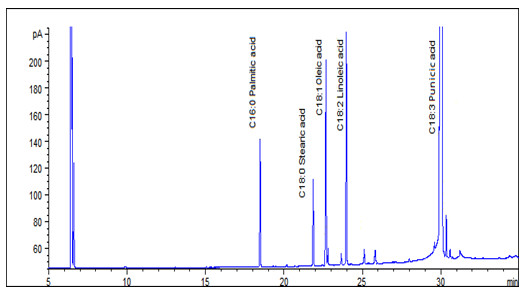FATTY ACIDS COMPOSITION AND PHYSICO-CHEMICAL CONSTANTS OF PUNICA GRANATUM L. SEED OIL
UDC 615.32
Аннотация
One of the important sources of essential fatty acids may be products of plant origin, in particular, oils extracted from seeds of wild and cultivated plants. One of these resources is wild-growing Punica granatum. The fatty acid composition of the lipid fractions of the seeds of wild-type pomegranate growing on the territory of Galalti, Siyazan region of the Azerbaijan Republic was assessed by gas chromatography after conversion to the methyl esters of the corresponding fatty acids. The highest oil yield – 12.92% was obtained by the extraction of the seeds at 60 °C for 8 h by Soxhlet extractor. Chromatographic analysis of the fatty oil of pomegranate seeds made it possible to establish the presence of 9 higher fatty acids. The main component of P. granatum seed oil was punicic acid (79.64%). Palmitic and stearic acids were found in small quantities. Content of these fatty acids were 3.29% and 2.43%, respectively. The least amount is accounted for by the share of myristic (0.03%) and heptadecanoic acids (0.03%).The analyses of physico-chemical constants and organoleptic properties of seed oil of P. granatum L. shows that the saponification numbers of wild-type pomegranate was 192.91 that indicates higher solubility of soap in water that can be made from it. The percentage of free fatty acids in our sample was 0.20% and the peroxide value – 3.03. The obtained results allow to consider the seed oil of this plant as good dietary fatty acid source. Thus, this study can provide valuable information for medicine and food industry for the development of drugs and food additives based on Azerbaijan wild-type pomegranate seed oil.
Скачивания
Metrics
Литература
Rustan A.C., Drevon C.A. Encyclopedia of life sciences, John Wiley & Sons, 2005, pp. 1–7. DOI: 10.1038/npg.els.0003894.
Schagen S.K., Zampeli V.A., Markantonaki E., Zoubolis C.C. Dematoendocrinol, 2012, vol. 4, no. 3, pp. 298–307. DOI: 10.14258/jcprm.2018022005.
Boligitsin K.G., Kaplitsin P.A., Dobrodeyeva L.K., Drujinina A.S., Ovcinnikov D.V., Parshina A.E., Shulgina E.V. Sverkhkriticheskiye flyuidy: teoriya i praktika, 2016, vol. 11, no. 3, pp. 58–70 (in Russ.).
Velikorodov A.V., Kovalev V.B. Nosachev S.B., Tyrkov A.G., Morozova L.V. Khimiya rastitel'nogo syr'ya, 2018, no. 2, pp.153–158 (in Russ.).
St. Angelo A.J. Crit. Rev. Food Sci., 1996, vol. 36, no. 3, pp. 175–224.
Farag R.S., Abdel-Latif M.S., Emam S., Tawfeek S. Agriculture and Soil Sciences, 2014, vol. 1 (6), pp. 86–93.
Koba K., Imamura J., Akashoshi A., Kohno-Murase J., Nishizono S., Iwabuchi M., Tanaka K., Sugano M. Journal of agricultural and food chemistry, 2007, Vol. 55, pp. 3741-3748. DOI: 10.1021/jf063264z.
Sassano G., Sanderson P., Franx J., Groot P., van Straalen J., Bassaganya-Riera. Journal of the Science of Food and Agriculture, 2009, vol. 89, pp. 1046–1052. DOI: 10.1002/jsfa.3552.
Caligiani A., Bonzanini F., Palla G., Cirlini M., Bruni R. Plant foods for human nutrition, 2010, vol. 65, pp. 277–283.
de Melo I.L.P., de Carvalho E.B.T., Mancini-Filho J. Journal of Human Nutrition & Food Science, 2014, vol. 2 (1), 1024.
Boroushaki T.M., Mollazadeh H., Afshari A.R. IJPSR, 2016, vol. 7(2), pp. 430–442. DOI: 10.13040/IJPSR.0975-8232.7(2).
Amri Z., Lazreg-Aref H., Mekni M., El-Gharbi S., Dabbaghi O., Mechri B., Hammami M. Biomed. Res., 2017, pp. 1–8
Morikawa K., Nonaka M., Narahara M., Torii I., Kawaguchi K., Yoshikawa T., Kumazawa Y., Morikawa S. Life Sciences, 2003, vol. 74, pp. 709–721.
Yamasaki M., Kitagawa T., Koyanagi N., Chujo H., Maeda H., Kohno-Murase J., Imamura J., Tachibana H., Yama-da K. Nutrition, 2006, no. 22, pp. 54–59. DOI: 10.1016/j.nut.2005.03.009.
Lansky E.P., Newman R.A. Journal of ethnopharmacology, 2007, vol. 109, pp. 177–206. DOI: 10.1016/j.jep.2006.09.006.
Monica V., Raquel H., Pinyi L., Josep B.R. Evidence-Based Complementary and Alternative Medicine, 2013, p. 18. DOI: 10.1155/2013/789764.
El-Shaarawy M.I., Nahapetian A. European Journal of Lipid Science and Technology, 1983, vol. 85 (3), pp. 123–126. DOI: 10.1002/lipi.19830850307
El-Nemr S.E., Ismail I.A., Ragalo M. Die Nahrung, 1990, no. 34, pp. 601–606. DOI: 10.1002/food.19900340706.
Melgarejo P., Salazar, D.M., Amoros, A. J. Sci. Food Agr., 1995, vol. 69, pp. 253–256.
Aruna P., Venkataramanamma D., Singh A.K., Singh R. Compr. Rev. Food Sci. Food Saf., 2016, no. 15, pp. 16–27. DOI: 10.1111/1541-4337.12171.
Marina A.M., Wan Rosli W.I., Noorhidayah M. The Open Conference Proceedings Journal, 2013, vol. 4, pp. 53–56. DOI: 10.2174/2210289201304020053.
Mukasa-Tebandeke I.-Z., Ssebuwufu P.J.M., Nyanzi S.A., Schumann A., Nyakairu G.W., Lugolobi F. American Journal of Analytical Chemistry, 2014, no. 5, pp. 1302–1312. DOI: 10.4236/ajac.2014.517136.

Copyright (c) 2019 Химия растительного сырья

Это произведение доступно по лицензии Creative Commons «Attribution» («Атрибуция») 4.0 Всемирная.

This work is licensed under a Creative Commons Attribution 4.0 International License.
Авторы, которые публикуются в данном журнале, соглашаются со следующими условиями:
1. Авторы сохраняют за собой авторские права на работу и передают журналу право первой публикации вместе с работой, одновременно лицензируя ее на условиях Creative Commons Attribution License, которая позволяет другим распространять данную работу с обязательным указанием авторства данной работы и ссылкой на оригинальную публикацию в этом журнале.
2. Авторы сохраняют право заключать отдельные, дополнительные контрактные соглашения на неэксклюзивное распространение версии работы, опубликованной этим журналом (например, разместить ее в университетском хранилище или опубликовать ее в книге), со ссылкой на оригинальную публикацию в этом журнале.
3. Авторам разрешается размещать их работу в сети Интернет (например, в университетском хранилище или на их персональном веб-сайте) до и во время процесса рассмотрения ее данным журналом, так как это может привести к продуктивному обсуждению, а также к большему количеству ссылок на данную опубликованную работу.















